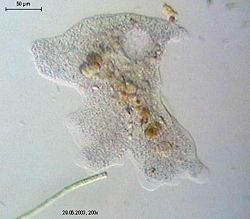Amoeba
| Amoeba | ||||||||||||
|---|---|---|---|---|---|---|---|---|---|---|---|---|
 |
||||||||||||
| Scientific classification | ||||||||||||
|
||||||||||||
| Species | ||||||||||||
|
Amoeba proteus |
Amoeba (sometimes amœba or ameba, plural amoebae) is a genus of protozoa that moves by means of pseudopods, and is well-known as a representative unicellular organism. The word amoeba or ameba is variously used to refer to it and its close relatives, now grouped as the Amoebozoa, or to all protozoa that move using pseudopods, otherwise termed amoeboids.
Contents |
History
The amoeba was first discovered by August Johann Rösel von Rosenhof in 1757.[1] Early naturalists referred to Amoeba as the Proteus animalcule after the Greek god Proteus who could change his shape. The name "amibe" was given to it by Bory de Saint-Vincent[2], from the Greek amoibè (αμοιβή), meaning change.[3]
Anatomy

The cell's organelles and cytoplasm are enclosed by a cell membrane, obtaining its food through phagocytosis. Amoebae have a single large tubular pseudopod at the anterior end, and several secondary ones branching to the sides. The most famous species, Amoeba proteus, is 700-800 μm in length but the species Amoeba dubia is as large as a millimeter, and visible to the naked eye. Its most recognizable features include one or more nuclei and a simple contractile vacuole to maintain osmotic equilibrium. Food enveloped by the amoeba is stored and digested in vacuoles. Amoebae, like other single-celled eukaryotic organisms, reproduce asexually via mitosis and cytokinesis, not to be confused with binary fission, which is how prokaryotes (bacteria) reproduce. In cases where the amoeba are forcibly divided, the portion that retains the nucleus will survive and form a new cell and cytoplasm, while the other portion dies. Amoebas also have no definite shape.[4]
Reaction to stimuli
Hypertonic and hypotonic solutions
Like most cells, amoebae are adversely affected by excessive osmotic pressure caused by extremely saline or dilute water. Amoebae will prevent the influx of salt in saline water, resulting in a net loss of water as the cell becomes isotonic with the environment, causing the cell to shrink. Placed into fresh water, amoebae will also attempt to match the concentration of the surrounding water, causing the cell to swell and sometimes burst.[5]
Amoebic cysts
In environments which are potentially lethal to the cell, an amoeba may become dormant by forming itself into a ball and secreting a protective membrane to become a microbial cyst. The cell remains in this state until it encounters more favourable conditions.[4] While in cyst form the amoeba will not replicate and may die if unable to emerge for a lengthy period of time.
Marine amoeba
Marine amoeba lack contractile vacuoles and their enzymes and organelles are not damaged by the salt water found in seas, oceans, salt swamps, salty rivers and ponds. Most are microscopic, but some can grow as large as grapes [6]
Food scarcity
Research published in the journal PLoS Biology in November 2008 shows several unusual types of behavior by amoebas in times of food scarcity. Amoebas can seek out other amoebas which are genetically similar. They can then clump together to form multi-cellular organisms in which some amoebas will become spores which can be moved to other locations to find more food, or they can become stalks which provide some height for the spores to then spread out. Most would rather be a spore than a stalk. [7]
Pathogenic interactions with other organisms
Some species of amoeba can infect other organisms pathogenically (causing disease):
- Entamoeba histolytica is the cause of amoebiasis, or amoebic dystentery"
- Naegleria fowleri (the "brain-eating amoeba") is a fresh-water-native species that can be fatal to humans if introduced through the nose.
- Acanthamoeba can cause amoebic keratitis and encephalitis in humans.
- Balamuthia mandrillaris is the cause of (often fatal) primary amoebic meningoencephalitis
References
- ↑ Leidy, Joseph (1878). "Amoeba proteus". The American Naturalist 12 (4): 235–238. doi:. http://links.jstor.org/sici?sici=0003-0147%28187804%2912%3A4%3C235%3AAP%3E2.0.CO%3B2-7. Retrieved on 2007-06-20.
- ↑ Audouin, Jean-Victor; et al (1826). Dictionnaire classique d'histoire naturelle. Rey et Gravier. pp. 5. http://books.google.com/books?id=1I8DAAAAQAAJ&pg=PA158&lpg=PA158&dq=%22bory+de+saint+vincent+jean+baptiste+genevieve+marcellin%22+amibe&source=web&ots=SCcqmYPPSy&sig=vje4JuVmdQzWrFqpXTw2UjRsgx8#PPA5,M1.
- ↑ McGrath, Kimberley; Blachford, Stacey (eds.) (2001). Gale Encyclopedia of Science Vol. 1: Aardvark-Catalyst (2nd ed.). Gale Group. ISBN 078764370X. OCLC 45477032 46337140 46337175 46337200 46337225 46337244 46337266.
- ↑ 4.0 4.1 "Amoeba" (html). Scienceclarified.com.
- ↑ Patterson, D.J. (1981). "Contractile vacuole complex behaviour as a diagnostic character for free living amoebae". Protistologica 17: 243–248.
- ↑ https://webspace.utexas.edu/lhc58/protist_slideshow/
- ↑ In Tough Times, Even Amoebas Turn to Family by Jeanna Bryner, Senior Writer LiveScience.com , nov. 25, 2008.